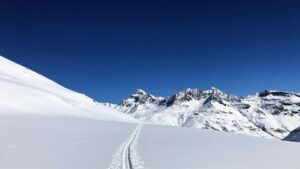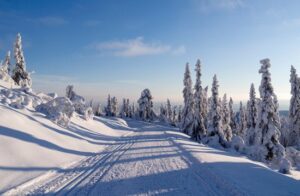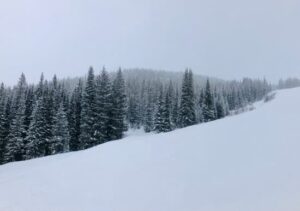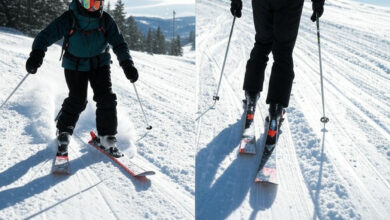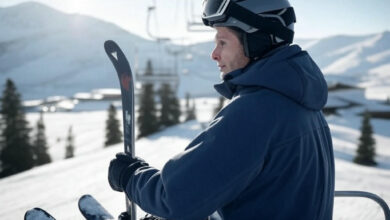What is the Best Temperature to Ski In? Finding Your Ideal Ski Temperature
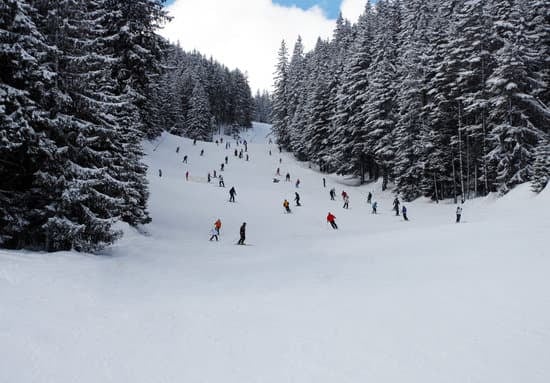
Figuring the Best Temperature to ski in is key to maximizing your enjoyment on the slopes. While many beginners might assume the colder the better for snow, the reality is that the optimal temperature for skiing involves a sweet spot. Generally, most skiers find that temperatures between 25°F (-4°C) and 35°F (2°C) offer a fantastic balance of good snow conditions and comfortable skiing. Going much below that can lead to icy conditions and shivering skiers while going above that can lead to slush and sticky snow.
While a temperature range of 20 to 30°F (-6 to -1°C) is widely considered to offer optimal comfort for skiers, the overall experience on the slopes is influenced by a confluence of additional factors. Snowpack characteristics, visibility conditions, humidity levels, and even antecedent temperatures collectively determine the quality of the skiing environment, impacting both enjoyment and safety. Understanding these interdependencies is critical for skiers seeking to maximize their time on the mountain.
The ideal skiing temperature range contributes directly to the quality of the snow. Within that 25°F to 35°F window, the snow tends to be firmer, faster, and more responsive. This allows for better control and edge hold, making for a more enjoyable experience whether you’re carving down groomers or navigating moguls. Furthermore, this temperature range minimizes the likelihood of ice patches forming overnight, leading to a safer skiing environment.
Determining the best temperature for skiing also hinges on personal preference and activity level. If you’re prone to getting cold easily, you might prefer the higher end of that range (30°F to 35°F). Conversely, if you tend to overheat while skiing hard, a temperature closer to 25°F might be more comfortable. Ultimately, it’s about finding the sweet spot where you can layer appropriately and maintain a comfortable body temperature throughout your ski day.

So, what is the best temp for skiing? There isn’t one single answer, but aiming for that 25°F to 35°F sweet spot is a great starting point. Keep an eye on the forecast, adjust your layering accordingly, and get ready to enjoy the snow! Consider factors like sunshine, wind chill, and your personal comfort level. With a little planning, you can find your perfect ski day, regardless of the exact temperature.
Contents
- 1 Cold Weather Conditions
- 2 Moderate Temperature Conditions
- 3 Warm Weather Conditions
- 4 Other Weather Factors
- 5 Importance Of Climate For Winter Activities
- 6 Factors That Contribute To The Best Conditions For Skiing
- 7 Understanding The Ideal Skiing Temperature
- 8 Conclusion
Cold Weather Conditions
Icy
0 – 15°F (or -15 to -25°C)
Best for: Experts Looking For Speed
Many skiers and snowboarders encounter ice on the slopes. While cold weather is a prerequisite for ice formation, a cold day doesn’t automatically guarantee icy conditions. This article explains the different types of ice you might find on a ski hill, how they form, and how to potentially identify them. Understanding these factors can help you stay safe and have a more enjoyable day on the mountain.
How Does Ice Form on Ski Slopes?
Ice formation on the slopes is more nuanced than simply freezing temperatures. Here are the common ways ice develops:
-
Humid Snow and Overnight Freezing: When it snows on a humid day, the groomed snow can become saturated with moisture. If temperatures drop significantly overnight, this saturated snow can harden into a layer of ice. This type of ice is often grippable and tends to soften as the sun warms it throughout the day.
-
Warm-to-Cold Transitions: The Most Treacherous Ice: The most dangerous type of ice occurs when a warm day is followed by a rapid drop in temperature. This creates a hard, slick surface that is difficult to grip with ski or snowboard edges. It’s often distinguishable by its color, appearing brownish or bluish-gray. Skiers should exercise extreme caution and avoid this type of ice.
-
Hardpack: Repeated Skiing and Insufficient Snow: Over time, a trail that is heavily skied without fresh snowfall can develop what’s called “hardpack.” The constant pressure from skis and snowboards compresses the snow, gradually turning it into a slick surface, ranging from slightly slippery to a sheet of ice.
Identifying Icy Patches
Being able to spot ice before you encounter it is crucial for safety. Key indicators include:
-
Color: As mentioned, ice formed from a warm-to-cold transition often has a brownish or bluish-gray tint.
-
Shine: Icy areas will typically appear shiny or reflective compared to regular snow.
-
Lack of Texture: Hardpack and icy spots often have a smooth, almost polished surface, unlike the textured appearance of fresh or groomed snow.
Icy Conditions: A Double-Edged Sword
While challenging to navigate, ice also offers increased speed. Some racers and adventurous skiers enjoy the thrill of skiing on icy slopes. However, it’s essential to recognize the increased risk and adjust your skiing accordingly.

Crud
“Crud” is a term skiers and snowboarders use to describe a particularly difficult and often unpleasant snow condition. It’s characterized by a mixture of frozen and partially melted snow, resulting in a bumpy, inconsistent, and unpredictable surface. Understanding how crud forms and how to ski it can help you improve your skills and better enjoy those less-than-perfect days on the mountain.
Best for: Absolutely no one
Imagine a landscape of hard, icy chunks interspersed with softer, slushy snow. That’s crud. It’s not smooth powder, it’s not consistent hardpack, and it’s definitely not the forgiving consistency of fresh snow. It’s a challenging mix that can make turning difficult and tiring.
How Does Crud Form?
Crud typically develops when there are fluctuating temperatures around freezing (32°F or 0°C). Here’s how it usually happens:
-
Freeze-Thaw Cycle: A classic scenario involves a warm day that melts the snow surface. When temperatures drop, especially overnight, the melted snow refreezes into hard, icy clumps.
-
Temperature Fluctuations During the Day: Even within a single day, crud can form. If a sunny morning softens the snow and then clouds roll in, causing a rapid temperature drop, the slushy snow can quickly refreeze into an uneven, chunky mess.
Why is Crud Challenging?
-
Inconsistent Surface: The biggest problem with crud is its unpredictability. One moment you’re skiing on a somewhat soft patch, the next you’re hitting a hard, icy chunk. This makes it difficult to maintain balance and control.
-
Increased Effort: Navigating crud requires more energy and precise technique. You need to actively steer and adjust your weight to stay balanced and avoid getting thrown off course.
-
Less Enjoyable: Let’s be honest, skiing in crud isn’t usually the most fun. It can be tiring and frustrating, and it’s definitely not the ideal condition for carving smooth turns.
The Upside: Crud Can Make You a Better Skier
While it might not be enjoyable at the time, skiing in crud can actually improve your skiing or snowboarding skills. It forces you to:
-
Improve Balance: Crud demands constant adjustments to maintain balance, which strengthens your core and improves your overall stability on skis or a snowboard.
-
Refine Technique: You have to be more precise with your turns and weight shifts when skiing crud. This helps you develop better overall technique.
-
Increase Adaptability: Learning to ski in crud teaches you to adapt to changing snow conditions, a valuable skill for any skier or snowboarder.
In summary, while crud is a challenging snow condition, understanding how it forms and practicing your technique can make you a more skilled and adaptable skier or snowboarder.
Moderate Temperature Conditions
15 to 30°F (or -10 to -1°C)
Deep Powder 10″ & Above
Best for: Wide Board Riders
For many skiers and snowboarders, the question isn’t whether to ski, but when to ski. And a big part of that decision comes down to the temperature. While any day on the mountain is a good day for some, understanding how temperature affects snow conditions can greatly improve your experience. This article explores the ideal skiing temperature and what to expect in different conditions.
The Sweet Spot: Around 20°F (-6°C) for Powder Days
Many powder hounds will tell you that the best temperature for skiing and snowboarding, especially for enjoying deep, fluffy powder, hovers around 20°F (-6°C). Why? Because at this temperature:
-
Snow Stays Light and Fluffy: Cold temperatures help keep the snow crystals dry and less prone to clumping. This creates that effortless “floating” sensation that powder lovers crave.
-
Snow Lasts Longer: Lower temperatures help maintain the snowpack throughout the day, meaning you can enjoy fresh powder for longer before it starts to get tracked out or turn to slush.
Who Loves Powder?
-
Wide Board Riders: Snowboarders, particularly those with wider boards designed for powder, often thrive in these conditions. The wider board provides more surface area, helping them “float” on top of the deep snow.
-
Experienced Skiers: While the powder is a blast, it requires skill. Maintaining speed and reading terrain are essential for navigating deep snow successfully.
Powder Isn’t for Everyone
While powder days are often celebrated, they can present challenges:
-
Beginners and Intermediates: If you’re still working on your skiing or snowboarding skills, deep powder can be tough. Maintaining speed is key, and if you’re not comfortable “letting your skis fly,” you might find yourself struggling.
-
East Coast Skiers (and Others Used to Groomed Runs): Skiers accustomed to hardpack or groomed conditions might find deep powder challenging at first. Different techniques are required to stay afloat and in control. Thin skis can sink more easily, leading to “face planting” down the slopes.
Important Considerations for Powder Days:
-
Terrain Awareness: Powder can cover obstacles like rocks and tree stumps. It’s crucial to be able to read the terrain and anticipate potential hazards.
-
Avalanche Safety: Avalanches are more common on powder days due to the unstable nature of fresh snow. However, if you stick to designated runs within the ski resort boundaries, this risk is generally low.
While the ideal skiing temperature varies depending on your skill level and preferences, many consider around 20°F (-6°C) to be the best temp for skiing, especially if you’re seeking that unforgettable powder experience. Just be sure to assess your abilities and the conditions before heading out!
Packed Powder
Best for: Everyone
After a fresh snowfall, the fluffy powder eventually gets compressed. This can happen naturally as skiers and snowboarders ride over it, or through the work of grooming machines. The result is “packed powder,” a snow condition that’s widely loved, especially by beginners and intermediate skiers. But what’s the ideal skiing temperature for enjoying packed powder? Let’s find out!
What is Packed Powder?
Packed powder is essentially powder snow that has been compacted, creating a more solid and consistent surface. It’s smoother and more predictable than deep, ungroomed powder, making it easier to control your skis or snowboard.
Why is Packed Powder so Popular?
-
Easy to Turn and Stop: The firm surface of packed powder provides good edge grip, making it easier to turn and stop. This is a huge confidence booster for beginners who are still learning the basics.
-
Great for Learning: Packed powder is a fantastic surface for practicing new skills and building confidence. It’s forgiving enough to allow for mistakes, but firm enough to provide stability.
-
Enjoyable for All Levels: While beginners and intermediates appreciate the ease of packed powder, experienced skiers and snowboarders also enjoy it for cruising and carving smooth turns.
Ideal Skiing Temperature for Packed Powder
While packed powder is enjoyable across a wide range of temperatures, the best temperature for skiing packed powder is generally slightly warmer than for deep powder. You’ll ideally want to find temperatures that are cold enough to keep the snow from becoming slushy, but not so cold that it turns icy. Here’s a guideline:
-
Ideal Range: Mid-20s to low 30s Fahrenheit (around -4°C to 0°C)
This ideal skiing temperature range helps the packed powder stay smooth and consistent throughout the day. If it gets too warm, the snow can become heavy and sticky. If it gets too cold, the packed powder might become hard and icy, making it more challenging to grip.
A Word About Moguls
It’s important to remember that on steeper, ungroomed trails, even after the powder is packed, the terrain often develops moguls (those bumps that form as skiers turn). Moguls can be challenging to master, but they’re a valuable skill for advanced skiers who want to take their skiing to the next level.
In short, packed powder is a fantastic snow condition that’s enjoyable for all levels, particularly beginners and intermediates. Finding the best temp for skiing packed powder, somewhere in the mid-20s to low 30s Fahrenheit (-4°C to 0°C) is a good starting point.
Warm Weather Conditions
32°F (0°C) and above
Slush
Best for: Surfy skiers
As the weather warms up, the snowpack begins to change. One result is “slush,” a snow condition that’s characteristic of spring skiing. While it might not be the fastest or most graceful way to ski, slush skiing offers a unique and often hilarious experience.
What is Slush?
Slush is essentially partially melted snow. It’s wet, heavy, and often sticky, unlike the light and fluffy powder of winter. You’ll usually find slush on warmer days when the temperature is above freezing. However, even on days when the temperature dips slightly below freezing, strong sunshine can still create slushy conditions.
Why is Slush Skiing Different?
-
Slower Speeds: Slush is much slower than skiing on packed powder or groomed runs. The resistance of the wet snow slows you down significantly.
-
“Grabbing”: Slush can “grab” the bottom of your skis or snowboard, causing them to stick and potentially throwing you forward. This requires good balance and quick reflexes.
Who Enjoys Slush Skiing?
-
“Surfy” Skiers: Slush skiing encourages a more relaxed and playful style, often described as “surfy.” This means riding with your weight back on the tails of your skis or snowboard, similar to surfing.
-
Spring Skiers: Slush is often associated with spring skiing, when the days are longer, the sun is brighter, and the atmosphere is more festive.
The Slush Skiing Experience
Slush skiing is less about perfect technique and more about having fun. You might see skiers and snowboarders:
-
Dressed in Fun Costumes: Spring skiing is a time to let loose and have fun, so you’ll often see people dressed in wacky outfits, including bikinis (weather permitting, of course!).
-
Enjoying Après-Ski: With warmer temperatures, the après-ski scene is often in full swing, with people enjoying drinks and music on outdoor patios.
-
Not Taking Themselves Too Seriously: Slush skiing isn’t about setting speed records or carving perfect turns. It’s about embracing the imperfect conditions and having a good time with friends.
In short, slush skiing is a unique and fun experience that’s characteristic of springtime on the slopes. It might not be the most efficient way to ski, but it’s definitely one of the most entertaining.
Other Weather Factors
We’ve talked a lot about how air temperature impacts snow conditions and the best temperature for skiing. But temperature isn’t the whole story. Other weather factors, like wind, cloud cover, and especially humidity, can significantly change how the snow feels and skis, even at the same air temperature. Finding the ideal skiing temperature truly means understanding these nuances.
Wind and Cloud Cover’s Impact
-
Icy Days: A cloudy and windy day at 32°F (0°C) on the East Coast can feel and ski much icier than a sunny day at 28°F (-2°C) in Utah. This is because wind can strip heat from the snow surface, and cloud cover prevents the sun from warming it.
-
“Clear and Cold” Warning: Be cautious of perfectly clear, sunny (“bluebird”) days. While they seem inviting, these conditions can lead to very rapid drops in temperature, potentially dipping well below zero.
The Role of Humidity
-
“Feels Like” Temperature: A humid 30°F (-1°C) can feel much colder on your skin than a dry 20°F (-6°C). Humidity increases the rate of heat loss from your body, making you feel colder.
-
East Coast vs. West Coast: The East Coast (like Vermont and New Hampshire) is generally more humid than the West (like Colorado and Utah). This is a major reason why the West is known for its light, fluffy powder, while the East Coast sometimes gets the less-flattering nickname “Ice Coast.”
Regional Climate and Snow Differences
-
East Coast: Heavier, Slower Snow: Snow on the East Coast tends to be heavier and slower because of the higher water content due to humidity. Some East Coast skiers actually prefer colder temperatures to reduce the water content and create lighter snow.
-
West Coast: Light, Fluffy Powder: The drier climate of the West Coast leads to lighter, fluffier powder snow, which is highly prized by skiers and snowboarders.
How Regional Differences Affect Ski Style
-
East Coast Ski Style: East Coast skiers often lean further forward, use narrower skis (skinny skis), and are highly skilled at navigating icy terrain. This is because they’ve adapted to the more challenging snow conditions.
-
West Coast Ski Style: West Coast skiers tend to lean further back, use wider skis (fatter skis), and often spend more time in terrain parks. The light powder makes for softer landings and easier maneuverability.
Beyond Best Temp for Skiing: Check the Conditions!
So, while the ideal skiing temperature is important, it’s just one piece of the puzzle. You need to consider humidity, wind, cloud cover, and regional climate to get a complete picture of the snow conditions. That’s why many skiers use weather apps like OnTheSnow to get real-time updates on all the relevant factors.
The key takeaway is that there is more to finding the ideal ski temperature than just the thermometer reading. Check the conditions to ensure a great day on the mountain.
Importance Of Climate For Winter Activities
When planning winter activities, whether it’s skiing, snowboarding, snowshoeing, or simply enjoying a scenic winter getaway, the climate is absolutely essential. It’s not just about being cold; the overall climate shapes the quality, safety, and duration of your winter experience.
Why Climate Matters for Winter Activities:
-
Snowfall Amounts: Obviously, you need snow! The amount of snowfall a destination receives directly impacts the types of activities possible and the overall experience. Ample snowfall ensures deep powder for skiing and snowboarding and creates a beautiful winter landscape.
-
Temperature Range: The temperature range is crucial. Too warm, and the snow melts. Too cold, and it can become icy or simply too uncomfortable to be outside for extended periods. The ideal skiing temperature (and temperature for other winter activities) provides the perfect balance.
-
Overall Experience: The right climate creates the magical “winter wonderland” atmosphere we all imagine. Think of gliding down perfectly groomed slopes surrounded by stunning scenery and fresh powder. That idyllic image starts with a good understanding of climatic factors.
-
Safety: Climate also directly impacts safety. Unstable snowpack (due to temperature fluctuations), avalanches, and extreme cold are all climate-related hazards that winter enthusiasts need to be aware of.

What Makes an Ideal Winter Climate?
An ideal climate for winter activities includes:
-
Consistent Snowfall: Regular snowfall throughout the winter season is essential.
-
Cold Temperatures (But Not Too Cold): Temperatures need to be cold enough to maintain the snowpack but not so cold as to be dangerous or uncomfortable. As we’ve discussed, for skiing, the best temperature for skiing might vary based on the type of snow.
-
Sunshine (But Not Too Much): While sunny days are welcome, too much sunshine can melt the snow and create icy conditions.
-
Limited Wind: Strong winds can make it feel much colder and can also create hazardous conditions on the slopes.
Understanding the importance of climate is key to planning a safe, enjoyable, and memorable winter experience. A destination with an ideal climate ensures optimal conditions for winter activities, enhancing both safety and enjoyment.
Factors That Contribute To The Best Conditions For Skiing
When chasing the perfect ski day, it’s easy to focus solely on fresh powder. However, creating truly exceptional skiing conditions involves a complex interplay of various factors. Here are 10 key elements that contribute to the best possible experience on the slopes:
-
Snowfall: Adequate snowfall is the bedrock of any great skiing destination. Consistent, ample snowfall builds a thick base layer, leading to well-groomed runs and plenty of powder for off-piste exploration. A good snow base sets the stage for everything else.
-
Temperature: Temperature plays a critical role in snow quality. Generally, colder temperatures produce lighter, drier snow, which is ideal for effortless turns and floating through powder. Warmer temperatures can result in wetter, heavier snow, making it harder to maneuver. The best temperature for skiing is often slightly below freezing.
-
Humidity: Low humidity promotes light, fluffy snow, while high humidity can create heavier, wetter snow. Finding a balance is key to achieving optimal skiing conditions. Dry air helps maintain the light and airy texture of the snow.
-
Wind Patterns: Wind significantly affects snow distribution on the slopes. While some wind is useful for creating powder stashes, too much wind can reduce visibility and lead to uneven snow distribution, creating icy patches and wind-scoured areas.
-
Elevation: Higher elevations typically experience colder temperatures and more consistent snowfall, making them prime destinations for skiing and snowboarding. Higher altitudes often translate to longer ski seasons, too.
-
Sunlight (or Lack Thereof): While sunny days are beautiful, excessive sunlight can melt the snow, especially in the spring. Conversely, too much cloud cover can lead to icy conditions. A balance of sun and clouds is often ideal.
-
Grooming: The quality of grooming is crucial for skiers who prefer groomed runs. Well-groomed slopes provide a smooth, consistent surface that’s perfect for carving and cruising. Even on a day with less-than-ideal snowfall, good grooming can make a huge difference.
-
Slope Aspect (Direction): Slopes that face north receive less direct sunlight and tend to retain snow longer, resulting in better conditions later in the day and later in the season. South-facing slopes, on the other hand, melt more quickly.
-
Avalanche Control: Effective avalanche control measures are essential for safety, especially in areas with steep terrain. Ski resorts that invest in avalanche mitigation ensure that skiers can enjoy the slopes with peace of mind.
-
Timing After a Storm: The period immediately after a significant snowfall is often the best time to ski. Fresh powder, clear skies, and a sense of excitement in the air create an unforgettable experience.

Creating the best conditions for skiing is a delicate art that depends on a confluence of these climatic and management-related factors. Understanding these elements helps skiers choose the right destination and the right time to hit the slopes for an unforgettable experience.
Understanding The Ideal Skiing Temperature
While everyone has their own preferences, experienced skiers and snowboarders generally agree that the best temperature for skiing falls within a specific range. Understanding this range can help you plan your trips and choose the right gear for optimal comfort and performance.
What is the Ideal Skiing Temperature Range?
-
The Range: Most skiers agree that the ideal skiing temperature lies between -5°C and -15°C (23°F and 5°F).
Why is This the Best Temp for Skiing?
-
Dry and Light Snow: Within this range, the snow remains dry and light, providing the perfect consistency for carving turns and enjoying powder. The snow is neither too icy nor too slushy.
-
Optimal Control: This temperature range allows you to maintain good control over your skis or snowboard. The snow provides enough grip without being too sticky or unpredictable.
-
Comfortable Conditions: While everyone’s tolerance to cold varies, this temperature range is generally considered comfortable for most skiers, with appropriate clothing layers.
What Happens Outside This Range?
-
Too Cold (Below -15°C / 5°F): Temperatures below -15°C can become uncomfortably cold, even with proper gear. Exposed skin can be at risk of frostbite, and the snow might become extremely hard and icy.
-
Too Warm (Above -5°C / 23°F): Warmer temperatures above -5°C can lead to slushy conditions, making it more challenging to maintain control on the slopes. The snow becomes wet and heavy, increasing friction and slowing you down.
Aiming for that ideal skiing temperature range between -5°C and -15°C (23°F and 5°F) gives you the best chance of finding perfect snow conditions and enjoying a fantastic day on the mountain!
Conclusion
While perfect conditions are always sought after, the true joy of skiing comes from adapting to whatever the mountain throws your way. By understanding the factors that contribute to different snow conditions, you can refine your technique, develop greater skill, and enjoy the thrill of the ride, regardless of the weather.

